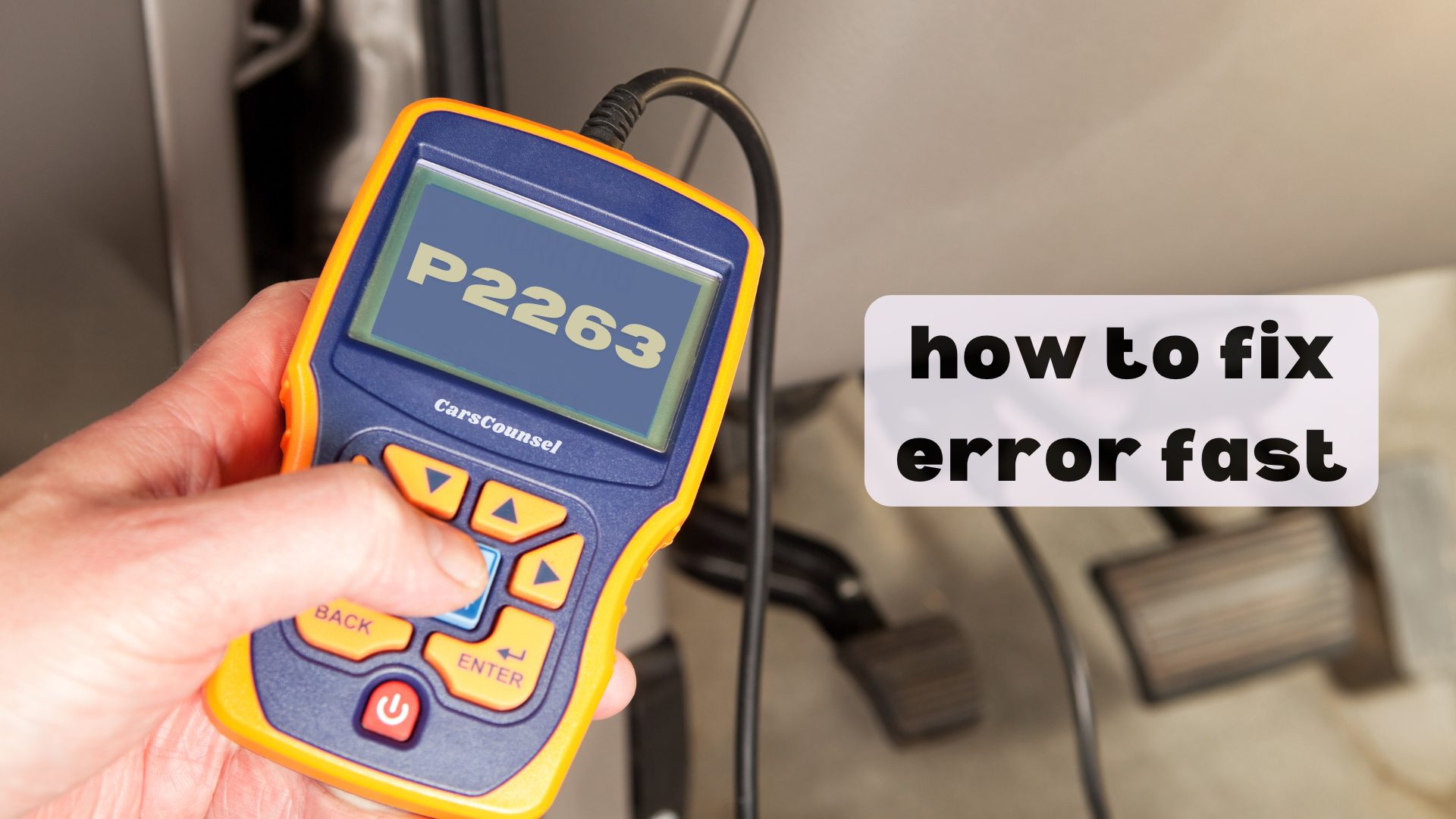Imagine you’re driving your car, and suddenly the check engine light comes on, showing a P2263 code. This code indicates a problem with the turbocharger system, but you might not know where to begin.
Don’t worry; there are quick and efficient ways to figure out and fix this OBD2 code issue. By checking critical areas like the wastegate, actuator, and wiring connections, you can find the root cause without wasting time.
Want to know the exact steps and tools to make your troubleshooting easier?

Quick Navigation
Key Takeaways
- Look over and replace any broken intake manifold runner control solenoids.
- Make sure all wiring connections are tight and not damaged or rusty.
- Check that the turbocharger wastegate, actuator, and position sensor are working properly.
- Run a diagnostic scan to look for any issues with the PCM/ECM and update the software if needed.
Understanding P2263 Code
Understanding the P2263 code is important because it means there’s a problem with your car’s turbocharger or performance booster. If you ignore it, you could end up with serious engine problems.
This code comes from the car’s engine diagnostics system when it spots issues with the turbo’s performance. It often points to problems with parts like the wastegate, actuator, or position sensor.
Ignoring this code can lead to other related problems and make engine damage worse. Usually, the P2263 code will turn on the check engine light, telling you to look into it.
It’s crucial to diagnose and fix this issue quickly to keep your turbo working well and avoid expensive repairs. Regular engine checks can help find and fix these problems early.
Common Causes
The P2263 code usually shows up because of problems like a bad intake manifold runner control solenoid, poor wiring connections, issues with the PCM/ECM, bypass valve troubles, or a failing turbocharger/supercharger.
These problems mess with how the boost pressure is controlled, which leads to performance issues. To avoid this, keep up with regular maintenance and pay attention to any warning lights on your dashboard.
If you’re not familiar with diagnosing turbo system problems, it’s best to get help from a professional. Certified mechanics have the right tools and know-how to figure out the issue and fix it.
They can also do thorough inspections and offer warranties on repairs, making sure the problem doesn’t come back. Taking care of these issues quickly can save you money and keep your vehicle running smoothly.
Intake Manifold Issues
Fixing intake manifold problems is important because a bad intake manifold runner control solenoid can get stuck and cause the P2263 code.
To avoid these issues, focus on:
- Intake cleaning: Get rid of carbon deposits and dirt that can block airflow and mess up the runner’s operation.
- Manifold upgrades: Think about replacing the stock intake manifold with a performance version to improve airflow and reliability.
These steps help keep your engine running well and prevent the P2263 code from coming back.
Cleaning the intake and upgrading the manifold can make your vehicle run more efficiently and last longer.
Don’t ignore these important parts when diagnosing and fixing the P2263 code.
Wiring and Connections
To fix the P2263 code, you need to carefully check the wiring and connections because any faults or loose connections can mess up the signals in the turbocharger system.
Start by looking over all the wiring for any damage, wear, or rust. Make sure all connectors are tight and clean.
Pay extra attention to the connections at key points like the turbocharger actuator and position sensor. Loose or rusty connections can cause problems that make it harder to diagnose the issue.
Use a multimeter to check for proper continuity and resistance in the wires. Keeping the connections in good shape will help prevent signal issues and make it easier to fix the P2263 code quickly.
PCM/ECM Malfunction
After you check the wiring and connections, look at the PCM/ECM to see if it might be causing problems with the turbocharger. Fixing the PCM and ECM is a key step to sorting out the P2263 code. Check for any damage or issues with these control modules since they’re crucial for managing turbo boost.
- Check for software updates: Make sure the PCM/ECM has the latest software to handle the turbocharger.
- Inspect for physical damage: Look for burnt parts or corrosion that might affect how the module works.
Fixing these problems quickly can get your turbocharger working at its best again and stop more issues from coming up.
Bypass Valve Problems
Check the bypass valve to make sure it’s working right, because if it isn’t, it can mess up the airflow and cause a P2263 error code.
Start by looking for any blockages, damage, or wear that could stop it from working properly. It’s important to keep the bypass valve in good shape, so make sure it opens and closes easily.
If you find any problems, you might need to replace the bypass valve to get it working correctly again. Use a diagnostic tool to check how the valve is performing and compare the results with what the manufacturer recommends.
Regularly taking care of the bypass valve can help prevent P2263 errors and keep your turbocharger working well. By fixing these issues quickly, you can avoid serious engine damage and keep your vehicle running smoothly.
Turbocharger Failures
Dealing with turbocharger problems is important because any issues can seriously affect your car’s engine performance and efficiency.
Keeping your turbocharger well-maintained ensures it runs smoothly and lasts longer, avoiding expensive repairs.
Here are some things you should focus on:
- Regular Checks: Look for oil leaks, worn-out bearings, and any cracks in the housing.
- Better Parts: Use high-quality parts to make your turbocharger more reliable and powerful.
Ignoring these tasks can lead to lower boost pressure, less power, and higher fuel consumption.
Diagnostic Steps
To accurately diagnose the P2263 code, follow these steps:
- Check Boost Pressure: Use a gauge or a diagnostic tool to see if the boost pressure is within the manufacturer’s specifications.
- Inspect the Wastegate: Look for any signs of damage or wear on the wastegate.
- Check the Actuator: Make sure the actuator is working properly.
- Examine the Position Sensor: Check the position sensor and its wiring for any faults or damage.
Use advanced diagnostic tools to thoroughly check each component.
These steps will help you pinpoint the exact issue for efficient troubleshooting.
Fixing the Error
When fixing the P2263 error, you’ll need to replace any faulty parts in the turbo or supercharger system to get it working properly again.
Start by checking and replacing parts like the wastegate, actuator, and position sensor. If you’re not sure about your skills or don’t have the right tools, it’s best to get help from a professional. Certified mechanics have the know-how and tools to make sure the repairs are done right and can take steps to prevent future problems.
Key steps include:
- Looking at the wastegate for any damage or wear.
- Testing the actuator to see if it works.
Affected Car Models
Some cars, like the Ford F-150, Dodge RAM, Jeep Cherokee, and Mazda CX-7, are more likely to show the P2263 code because of problems with their turbo boost systems.
Regular turbocharger maintenance is important for these vehicles to avoid this error.
The Ford F-150 and Dodge RAM often have issues with solenoids and intake runners, while the Jeep Cherokee and Mazda CX-7 face similar problems.
Upgrading your compressor can also help avoid these errors.
By keeping up with turbocharger maintenance and considering compressor upgrades, you can prevent the P2263 code and keep your car running smoothly.
Watching these parts and fixing problems quickly will save you from expensive engine damage and big repair bills.
More OBD-II Codes
Frequently Asked Questions
Can the P2263 Code Affect Fuel Efficiency?
Yes, the P2263 code can impact fuel efficiency. If the turbocharger isn’t working properly, it messes up the air-fuel mixture, causing poor combustion. Fixing this issue quickly ensures your car runs well and saves fuel.
How Much Does a Typical Repair Cost for P2263?
Fixing a P2263 issue usually costs between $200 and $600. Plus, there are diagnostic fees of about $100. Taking care of it promptly can save you from more engine problems and higher costs later.
Are Aftermarket Parts Reliable for Fixing P2263?
Aftermarket parts can work well for fixing P2263 if you pick good-quality ones. But their reliability isn’t always the same. Bad parts might hurt performance, so make sure they’re compatible and come from well-known manufacturers.
Can Extreme Weather Conditions Trigger the P2263 Code?
Yes, extreme weather can cause the P2263 code to appear. Changes in temperature can mess with the sensors and affect how well the turbocharger works. Regular maintenance and keeping an eye on things can help prevent this.
How Long Can I Drive With the P2263 Code Before It Causes Damage?
You shouldn’t drive with the P2263 code for long. The longer you drive, the more you risk serious engine problems and expensive repairs. Getting it checked and fixed right away can stop the problem from getting worse and keep your car running smoothly.
Conclusion
To fix the P2263 code quickly, start by checking the turbocharger system, especially the wastegate, actuator, and position sensor.
Make sure all the wiring and connections are in good shape and not corroded. Replace any broken parts and keep the intake manifold and bypass valve in good condition.
Using advanced diagnostic tools will help you pinpoint the problem more accurately.
By following these steps, you can fix the issue efficiently and prevent future problems.
Don’t let this issue affect your vehicle’s performance.

